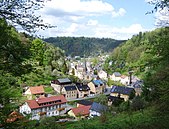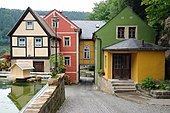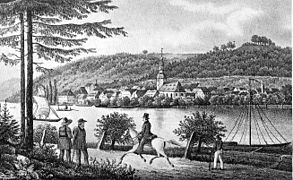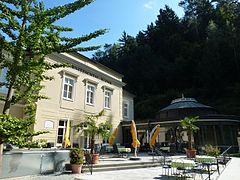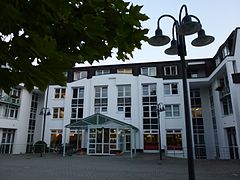Bad Schandau
| coat of arms | Germany map | |
|---|---|---|

|
Coordinates: 50 ° 55 ' N , 14 ° 9' E |
|
| Basic data | ||
| State : | Saxony | |
| County : | Saxon Switzerland-Eastern Ore Mountains | |
| Management Community : | Bad Schandau | |
| Height : | 146 m above sea level NHN | |
| Area : | 46.76 km 2 | |
| Residents: | 3604 (Dec. 31, 2019) | |
| Population density : | 77 inhabitants per km 2 | |
| Postcodes : | 01812-01814 | |
| Area code : | 035022 | |
| License plate : | PIR, DW, FTL, SEB | |
| Community key : | 14 6 28 030 | |
| City structure: | 8 districts | |
City administration address : |
Dresdner Strasse 3 01814 Bad Schandau |
|
| Website : | ||
| Mayor : | Thomas Kunack (WV Tourism) | |
| Location of the city of Bad Schandau in the Saxon Switzerland-Eastern Ore Mountains district | ||
Bad Schandau (until 1920 Schandau ) is a small Saxon town as well as a state-recognized Kneipp health resort and resort in the district of Saxon Switzerland-Eastern Ore Mountains on the Elbe .
geography
Bad Schandau is located to the right of the Elbe, directly at the Saxon Switzerland National Park in the Elbe Sandstone Mountains ; the national park center is in the city. The original town center nestles against the steep sandstone cliffs of the right, northern bank of the Elbe and is partially forced into the narrow valley of the Kirnitzsch . The town center is 121.7 m above sea level. HN (market), while the heights over 400 meters above sea level. HN lie. An overland tram, the Kirnitzschtalbahn , accompanies the river for several kilometers and opens up parts of the Upper Saxon Switzerland.
City structure
The city consists of the old urban settlement Schandau and the eight districts of Krippen , Neuporschdorf , Porschdorf , Postelwitz , Prossen , Schmilka , Ostrau and Waltersdorf .
Cribs
Krippen is the only district of Bad Schandau on the left bank of the Elbe. Nativity scenes were the sphere of activity of Friedrich Gottlob Keller (1816–1895), the inventor of wood pulp for paper production, to whom a museum is dedicated here.
Postelwitz
The Sommerfrische Postelwitz is a district of Bad Schandau that is pressed tightly against the rocky slope and consists of a single row of houses about 2 kilometers up the Elbe below the Schrammsteine . The originally Slavic settlement of raftsmen, fishermen, stone breakers and shipbuilders is documented since 1446. Ship anchor smiths worked in the village until 1968. The local sandstone quarries (at times the most important in the area) were in operation from the second half of the 16th century until 1907, were then reforested and are now accessible via the Elbe promenade. The preserved half-timbered houses No. 55-67, the so-called Seven Brothers Houses, go back to a legend in which a boatman is said to have built a house for his sons. But his own building would have towered over them all. High water marks of the Elbe are attached to houses nos. 43 and 69 as well as to the ferryman's house . On April 1, 1934, it was incorporated into Bad Schandau. In 2009 Postelwitz had 282 inhabitants (1999: 323 inhabitants).
Schmilka
Schmilka is the border town to the Czech Republic on the Elbe with 137 inhabitants (2009). The place is the starting point for hikes, for example to the Schrammsteinen and the Großer Winterberg .
Ostrau
Ostrau on the Ostrauer disk rises 130 m above the Elbe and is 245 m above sea level. NN . The ice age loess loam on the flatness of the Ostrava disk allowed the construction of a German village for what were formerly seven farms in an early settlement period. Since 1904, Ostrau has been directly connected to the main town by a free-standing electric passenger elevator, which was built at the suggestion of hotelier Rudolf Sendig and financed by him. Old half-timbered farms , pensions, holiday homes, a modern health resort, inns, villas and single-family houses represent the facilities of the district. With almost 100 residents, the suburb lived a very secluded existence at its exposed height until the end of the 19th century. But it was precisely this location with a wide panoramic view that gave rise to the ambitious plan around 1900 to create an exclusive tourist center with sports facilities, a health resort and an airfield (World Sports Field project). But only the elevator was built, and wooden villas in Scandinavian style were built on the Ostrauer Ring, also on the initiative of Sendig. On April 1, 1934, it was incorporated into Bad Schandau. In 2007 Ostrau had 419 inhabitants (1999: 541 inhabitants).
history
In the first half of the 14th century, German settlers acquired the Elbe meadows between Rathmannsdorf and Postelwitz from the feudal rule of Hohnstein and founded a trading center here. Schandau was first mentioned in a document in 1445 and, due to its important location as a trading center on the Elbe, was given the status of a town in 1467 by the council constitution. Bad Schandau has been a health resort and summer resort since around 1800 . In 1877 the place got a fixed Elbe crossing with the Carolabrücke . In 1920 the city was given the official title of "Bad", and in 1936 it was named a "Kneipp spa".
In 1953 a tent camp of the Free German Youth (FDJ) was set up for the delegates of the 4th World Festival of Youth and Students in Bucharest .
The city is the smallest German town with a self-managed tram (Schandau - Lichtenhainer waterfall line ), the so-called Kirnitzschtalbahn (operating since 1898).
On January 1, 2000, the municipalities of Bad Schandau, Porschdorf , Rathmannsdorf and Reinhardtsdorf-Schöna formed the Bad Schandau administrative community in order to be able to handle the administrative business together. The administrative seat was Bad Schandau.
Bad Schandau was severely affected by the Elbe flood events in 1845 , 2002 , 2006 and 2013 :
The flood was on 16./17. August 2002 9.78 m above mean water, 4.28 m above the market and 3.46 m high in the church. Maximum level Schöna 12.04 (maximum level Bad Schandau 11.88), flow rate 4780 m³ / s. It peaked 4 cm below the 1845 flood.
On April 3, 2006, the high tide reached a high of 6.78 m above mean water and 1.28 m above the market at around 11 p.m. Maximum level at Schöna 8.88 m, flow rate 2720 m³ / s. The market was flooded 7.60 m at the Schöna gauge.
On June 6, 2013, at around 3:00 p.m., the flood reached a high of 8.55 m above mean water and 3.05 m above the market. Maximum level Schöna 10.65 m, cf. also
On January 1, 2012, the municipality of Porschdorf with the districts Neuporschdorf, Waltersdorf and Prossen was incorporated into Bad Schandau. Both places were only connected by a very short border.
politics
City council
The local elections on May 25, 2014 led to the following result with a turnout of 60.4% (- 1.4):
| Party / list | Share of votes | +/- | Seats | +/- |
|---|---|---|---|---|
| CDU | 34.1% | + 1.1 | 6th | + 1 |
| The left | 15.0% | + 0.3 | 2 | ± 0 |
| NPD | 6.6% | + 0.4 | 1 | ± 0 |
| WV Tourism | 25.4% | - 0.2 * | 5 | + 1 |
| WV Prossen | 7.8% | 1 | + 1 | |
| WV Porschdorf | 7.4% | 1 | + 1 |
+/-: Change compared to local elections on June 7, 2009, * voter associations together
mayor
In June 2015, Thomas Kunack was elected to succeed Andreas Eggert in the second ballot.
administration
Bad Schandau is a fulfilling community of the administrative community with the communities of Reinhardtsdorf-Schöna and Rathmannsdorf .
coat of arms
In 1480, Schandau received the right to use a coat of arms and a seal from Prince Ernst of Saxony . The coat of arms shows a ship with sails, a presumed reference to the importance of the Elbe shipping.
Town twinning
Bad Schandau maintains city partnerships with Überlingen on Lake Constance , Gößweinstein , Fichtenau , Česká Kamenice in the Czech Republic and Lądek-Zdrój in Poland .
Culture and sights

Museums
- City Gallery
- Local museum
- National Park Center - operated by the Saxon State Foundation for Nature and Environment ; in a former cinema building, built in 1953 (provides information about the flora and fauna of the Saxon - Bohemian Switzerland national park region and their connection with the geology of the Elbe Sandstone Mountains and land use)
- Friedrich-Gottlob-Keller -Museum Krippen, Friedrich-Gottlob-Keller-Straße 76 (information about the invention and inventor of wood pulp paper )
Buildings / sights
Bad Schandau's city skyline on the right bank of the Elbe is characterized by the Wilhelminian-style hotels lining the Elbe , the two Elbe bridges and the St. John's Church.
From 2002 to 2007 extensive renovation work was carried out on the Wilhelminian-style hotels on the Elbe front - the most famous in the 19th century was the steamship . The buildings were gutted from the ground up and the facades restored. Some apartment complexes are housed in bath villas. The ensemble was reopened in 2007 under the name Elbresidenz Bad Schandau .
The massive Protestant St. John's Church with its octagonal west tower has existed in its current form since 1679. The tower was given the lantern-topped baroque dome in 1711 after a city fire. The interior design of the church with a wooden coffered ceiling , one-story galleries and colored windows in the chancel is the result of the fundamental redesign in 1876/77. The two-storey renaissance altar made of sandstone, which the Dresden sculptor Hans Walther originally created for the Dresden Kreuzkirche and which stood in Dresden's Annenkirche from 1760 to 1902, is particularly valuable .
The main attraction of the market square with the town hall (1863) and some Renaissance buildings (Brauhof Gambrinus , house No. 1 with half-timbered upper floor ) has been the Sendig fountain in front of the church since 1896, which lost its Art Nouveau sculpture with sculptures during the Second World War for reasons that have not yet been clarified . The reconstruction of this essay was carried out from 1994 to 2011.
The spa facilities and the 3500 m² Bad Schandau Botanical Garden with over 1500 plant species (created in 1900) are located at the entrance to the Kirnitzschtal. At the stop of the Kirnitzschtalbahn there is the so-called ice age stone for the purpose of documentation that in the Pleistocene the closed inland ice cover reached from Scandinavia to here. To the west of the city park is the Schandauer Schlossberg, including the Schomberg Castle Stables .
The Catholic Church is right in front of the slope on the right bank of the river, near the Park Hotel and the passenger elevator to Ostrau. This building was built as Russian diplomatic accommodation in the classicist Saint Petersburg villa style of the 19th century and has been used by the Catholic Church as a sacred building since 1924.
The historic passenger elevator to Ostrau is a 50-meter-high, free-standing iron construction that leads to the higher-lying district of Ostrau. The hotelier Rudolf Sendig had this electrically operated elevator built in 1904 by the companies Kelle & Hildebrandt (iron construction) and Kühnscherf & Söhne (elevator). The elevator was officially inaugurated on Easter Sunday 1905, and the riveted framework structure, which has been a listed building since 1954, was restored in 1989–1990. Because of the view over Saxon Switzerland around Bad Schandau, especially the Schrammsteine , but also because of the subtle Art Nouveau ornamentation, a trip with this technical monument is one of the tourist attractions advertised.
The so-called Ostrauer Scheibe can also be reached by car on a hiking trail from the Botanical Garden in the Kirnitzschtal, via the old Fuhrweg (Ostrauer Berg), as well as a serpentine road from Postelwitz.
The new Schrammstein bath, which was badly damaged by the Elbe flood in 2002 before it opened, was put into operation by the new operator Toskanaworld GmbH on October 1, 2004 as the Toskana Therme after the insolvency of the original operator. There are similar systems from the same operator in Bad Sulza and Bad Orb . The construction costs for the bath amounted to 38 million DM. Another flood in June 2013 caused damage of 6.3 million euros; the bath was closed until April 2014. Every year around 180,000 visitors visit the Toskana Therme, 25 employees generate a turnover of three million euros.
In addition to the National Park Center, the National Park's youth education center is located in the area of the city of Bad Schandau. It is located on the Sellnitz .
Memorials
- Luther monument from 1817 with Luther oak, on the Luther Trail from Bad Schandau to Ostrau
- VVN monument in the spa gardens for the victims of fascism
- Memorial stone in front of the mountain hut above the Zahnsgrund in the Ostrau district for the communist resistance fighter Kurt Schlosser , who was murdered in Dresden in 1944
- Commemorative plaque from 1957 on a cave in the Schrammsteinen in memory of the resistance fighters of the United Climbing Department Dresden
- Krinitz grave on the Großer Winterberg in memory of a student who was probably murdered there in 1908
dialect
In Bad Schandau, a special form of the Saxon dialect is spoken: the southeast Meissen niche , which is one of the five Meissen dialects .
Economy and Infrastructure
traffic

The railway line runs along the left bank of the Elbe ( Dresden – Děčín line ). The Bad Schandau train station was completely renovated and renewed from 2008 to 2011. Today it has four tracks with platforms and two tracks for passing trains without platforms. A bus station was built on part of the station . In 2012, the station was voted the best tourist station by the rail alliance Allianz pro Schiene .
Bad Schandau is the stopping point for EuroCity connections between Berlin and Prague . Individual trains continue to Budapest , Hamburg and Binz . In regional traffic, Bad Schandau is served by the S 1 line ( Schöna - Meißen-Triebischtal ) of the Dresden S-Bahn , regional trains also run to Sebnitz and Neustadt in Saxony ( Bautzen – Bad Schandau line ) and cross-border to Rumburk , Děčín and Litoměřice in the Czech Republic .
The city center can be reached from the train station by ferry or across the Elbe bridge . Other ferries run between the actual Schandau town center and Krippen , between Krippen and the Postelwitz district, and between the Schmilka district and the Schmilka-Hirschmühle train station belonging to Reinhardtsdorf-Schöna .
The city can also be reached with the regional bus lines of the regional traffic Saxon Switzerland-Eastern Ore Mountains .
The Kirnitzschtalbahn , a historic tram, runs from the city center to the Lichtenhain waterfall . The Elbe Cycle Path runs on both sides of the banks of the Elbe .
Rehabilitation clinics
- Kirnitzschtal-Klinik: Specialized in conservative orthopedic therapy of acute and degenerative diseases of the muscular and skeletal system
- Falkenstein Clinic in the Ostrau district: around 125 employees, specializing in the treatment of digestive and metabolic diseases, cardiovascular diseases and diabetes
Kirnitzschtal Clinic with a memorial plaque for Theodor Körner
school
The Erich Wustmann primary school is located on the edge of the spa park. Secondary schools are located in Königstein (Saxon Switzerland) , Sebnitz and Pirna .
Personalities
The hotelier and city councilor Rudolf Sendig (1848–1928) had an electrically operated tram put into operation in 1898, which covered the 8 kilometers through the Kirnitzschtal in 32 minutes. The passenger elevator that connected the city with the Ostrau district in one minute was also his work. He also built the Sendig fountain on the market square in Bad Schandau .
Friedrich Gottlob Keller (1816–1895), the inventor of wood pulp paper, lived in the Krippen district from 1853 to 1895 . A small museum at Friedrich-Gottlob-Keller-Straße 76 commemorates the invention.
sons and daughters of the town
- Christian Andreas Siber (1662–1704), educator and Lutheran theologian
- Urban Gottfried Siber (1669–1741), Protestant theologian
- Carl Gottlieb Hering (1766-1853), composer
- Gotthelf Traugott Esaias Häntzschel (1779–1848), businessman and politician, member of the state parliament (Kingdom of Saxony)
- Heinrich Leberecht Fleischer (1801–1888), orientalist
- Gustav Biedermann Günther (1801–1866), surgeon and university professor
- Rudolph Hering (1803–1888), Saxon mountain ridge, after which the Rudolphschacht in the Marienberger Revier was named
- Otto Graf zu Münster (1825-1893), head of the district in Leipzig
- Ernst Grumbt (1840–1917), entrepreneur and member of the Reichstag
- Johannes Käubler (1849–1924), lawyer and MdL
- Otto Höfer (1861–1919), high school teacher and classical philologist
- Franz Biener (1866–1940), politician
- Willy Häntzschel (1906–1993), mountaineer
- Karl Schröder (1912–1996), cameraman
- Jürgen Kleditzsch (* 1944), doctor, Minister of Health of the GDR, member of the Bundestag
Honorary citizen
- Wolfgang Spang, honorary citizen in recognition of his services to the good of the city of Bad Schandau since May 15, 2013.
- Wolfgang Schindele, honorary citizen in recognition of his services to the city partnership between the cities of Überlingen and Bad Schandau since May 15, 2013.
- Werner Kirschner, honorary citizen in recognition of his services to the city since March 21, 2013.
- Reinhard Ebersbach , Lord Mayor of the twin town of Überlingen. Honorary citizen in recognition of his services to the city partnership between the cities of Überlingen and Bad Schandau since October 23, 1993.
- Ivan Grigoryevich Kazakov, 1st city commander after 1945. Awarded honorary citizenship on October 7, 1972 in recognition and thanks for the help and support provided.
- Max Richter, 1895 - February 17, 1970, city councilor for many years. Honorary citizen since April 23, 1966 in recognition of his work.
- Erich Wustmann , ethnologist and travel writer who lived (with interruptions) between 1909 and 1994 in Ostrau. Honorary citizen in recognition of his services in carrying out a successful expedition into the interior of Brazil since August 14, 1956.
- Rudolf Sendig , so, honorary citizen since November 9, 1921 in recognition of his services in the field of tourism.
- Heinrich Leberecht Fleischer , see above , honorary citizen since 1874.
- Michler (unsure, according to a gravestone inscription).
Others
During the shooting of his film Inglourious Basterds , the US filmmaker Quentin Tarantino stayed temporarily in the Bad Schandau Hotel Elbresidenz . Actress Kate Winslet also lived there during the filming of the film " The Reader ". The hotel was used as the location for the filming of The Cloud Atlas with Tom Hanks on October 13, 2011.
literature
- From the old and new Schandau. Ramm & Seemann, Leipzig 1896 ( digitized )
- Arthur Glootz: The Schandauer Chronicle. Bad Schandau 1917
- Johann Gottfried Grünberg: History of the city of Schandau on the Elbe . Dresden 1739 ( digitized version )
- Gerhard Walter: Vacation in Bad Schandau. VEB FA Brockhaus Leipzig 1964
- H. Lüttich: Bad Schandau and the Saxon-Bohemian Switzerland. Series of City Pictures and Landscapes from All Over the World Vol. 70, Zurich 1889 ( digitized ; PDF; 14.6 MB)
- Theodor Schäfer: Guide through Schandau and its surroundings . Meinhold & Sons, Dresden 1895 ( digitized version )
- Oscar Sorber: History of the city of Schandau and the surrounding villages according to historical sources ... Sebnitz 1876 ( digitized version )
- Richard Steche : Schandau. In: Descriptive representation of the older architectural and art monuments of the Kingdom of Saxony. 1. Booklet: Official Authority Pirna . CC Meinhold, Dresden 1882, p. 80.
Web links
- City administration and tourism
- Image video "Bad Schandau - spa town in the heart of the Elbe Sandstone Mountains"
- Bad Schandau in the Digital Historical Directory of Saxony
- Literature about Bad Schandau in the Saxon Bibliography
- coat of arms
Individual evidence
- ↑ Population of the Free State of Saxony by municipalities on December 31, 2019 ( help on this ).
- ↑ Facebook entry
- ^ Bad Schandau administrative community in the Saxony regional register
- ^ Dresden Waterways and Shipping Office
- ↑ Flood in Bad Schandau - Living with the recurring catastrophe on faz.net, accessed on June 8, 2017
- ↑ Balance 2011: 12 voluntary community associations in Saxony , Medienservice Sachsen
- ↑ Local election Saxony 2014, results of the city / municipal council elections in Bad Schandau on sz-online.de, accessed on June 8, 2017
- ↑ https://www.statistik.sachsen.de/wpr_alt/pkg_s10_bmlr.prc_erg_bm_a?p_bz_bzid=BM151&p_ebene=GE&p_ort=14628030
- ↑ Information on the building history of the ensemble on the hotel website ( Memento from April 2, 2012 in the Internet Archive )
- ↑ http://bad-schandau.de/botanischer-garten-im-kirnitzschtal/
- ↑ Gunnar Klehm: The successful Toskana Therme model for a fee at sz-online.de, accessed on October 10, 2014
- ↑ Stefan Robert Weißenborn: Everything is in flux - paddling through the Elbe Sandstone Mountains on spiegel.de, accessed on June 8, 2017




